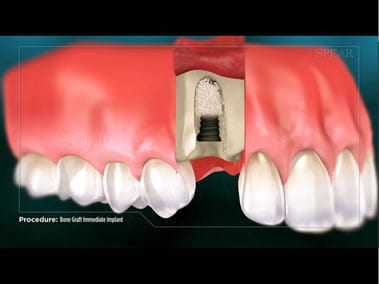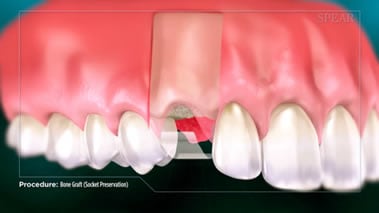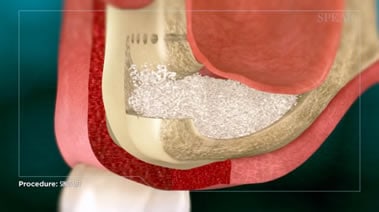Bone Grafting in Preparation for Dental Implants

Bone Grafting for Dental Implants
Bone grafting in preparation for dental implants is extremely common. The implant posts must be inserted into a certain amount of healthy bone to be successful. Being surrounded by healthy bone ensures that the implant will be held firmly in place while the bone gradually grows to the implant post during the process of osteointegration. This is critical to the success of the implant treatment.
Sufficient Bone is Required for Dental Implants
If there isn’t sufficient bone, there is an increased chance that the implants will fail to fully integrate and they may become loose. This might cause failure of the implant and require removal. Bone grafting is commonly done in preparation for implant placement.


Socket Preservation
When a tooth removal is necessary, it is possible that the surrounding bone could have become damaged by disease or infection. Additionally, tooth removal can result in dimensional changes to the surrounding bone and gums.
The socket preservation technique involves filling the empty socket with bone grafting material. Afterwards, the bone grafting material may be covered up with an artificial membrane or platelet rich fibrin. These membranes contain special proteins to help stimulate your body to repair the empty socket and to prevent the gum tissue from growing into the bone.
This method can be enormously successful helping to eliminate the shrinkage and collapse of bone and gum tissue. The newly formed bone in the previously empty socket provides a strong and stable foundation for dental implant therapy.
Ridge Augmentation
If bone grafting is not performed at the time of extraction, the bony architecture can change. This may result in inadequate bone height or width for placement of dental implants to restore the space. Ridge augmentation is another common procedure carried out following tooth extraction. It helps to recreate the natural contour of the jaw and gums that may have been lost due to bone resorption.
The purpose of ridge augmentation is to rebuild the bony ridge to its original height and width through extensive grafting procedures. This helps to ensure that the dental implants will have plenty of bone to support them. This will improve the aesthetics of the final restoration once the implants have been restored.
Generally, this type of bone graft will need to heal for 2 to 6 months before dental implant placement. Occasionally, it might be possible to place the implants at the same time as the ridge augmentation.

Sinus Lift/Augmentation
The maxillary sinuses are located just above your upper jaw, on either side of your nose. They are empty air-filled cavities.
It is very common for natural tooth roots to extend up into these maxillary sinuses. If these teeth are extracted, there will only be a very thin wall of bone remaining between the sinus and the mouth. This is not sufficient to support dental implants, which is why you may need a sinus lift or graft.
This procedure will build up the bone in the area around your sinuses helping to ensure dental implant treatment will be a success.
To do this procedure, Dr. Atkins will need to make an incision in your gums to expose the jawbone directly underneath your sinuses. A small opening is then cut into the bone, exposing the membrane in between your sinuses and your jawbone. The membrane is gently lifted or pushed upward, creating a space in between the membrane and your jawbone which can then be filled with bone grafting material. Once the bone graft is in position, the incision in your gums will be stitched up and the healing process begins.
Sometimes it is possible to carry out a sinus augmentation while placing your dental implant, but if a substantial amount of bone is needed then it may be better carried out as a separate procedure. The bone graft will need to heal for 4 to 6 months before your implant can be inserted.

Bone Loss in Teeth – Different Types of Bone Grafts
Autogenous
An autogenous bone graft, also known as an autograft, uses bone taken from another site in your body. Typical sites include the leg, hip, chin or jaw. Also, the harvested bone is live which means it has certain cellular elements which will help enhance the production of new bone.
Xenografts
The bone used in a xenograft is usually bovine. It is processed at an extremely high temperature to avoid any risk of contamination and is extensively tested to make sure it is safe for use. A xenograft will provide a framework, enabling your own bone to grow on and around the surrounding areas until there is sufficient bone for dental implants.
Allografts
An allograft uses highly processed bone taken from a donor which may be freeze-dried, irradiated, or chemically treated to ensure its safety. It is extensively tested to eliminate the risk of contamination. Like a xenograft, allogenic bone will provide a framework for your body to grow new bone cells, but it cannot produce new cells on its own. Both xenografts and allografts are advantageous in that no additional surgery is required to harvest the bone from somewhere else in your body.
Alloplast
An alloplast is a graft made from entirely synthetic materials. Artificial bone grafting materials are extremely sophisticated and contain a variety of different substances. They may have a combination of collagen, protein, and growth factors that are designed to help promote the formation of new bone cells and to promote healing. This type of synthetic bone is extremely reliable.
Soft Tissue Grafting
Sometimes Dr. Atkins will also suggest a soft tissue ridge augmentation. This surgical procedure can be used to replace lost gum tissue with your own soft tissue or other allogenic soft tissue grafting materials. He can ensure that the alveolar ridge has the correct contours and tissue thickness so that the final implant restoration will look natural and aesthetically pleasing.
